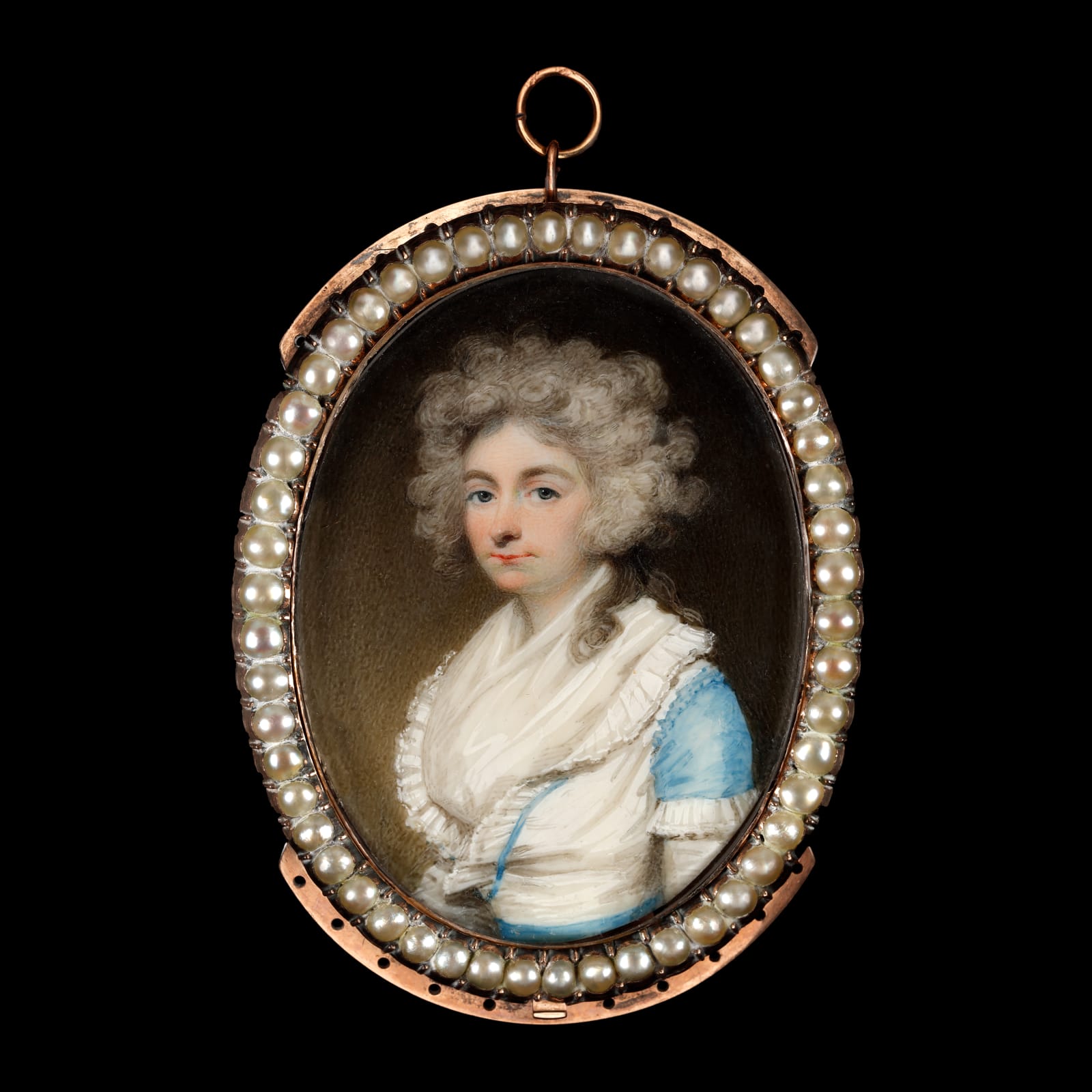
Henry Edridge
A Lady, wearing blue and white dress with white fichu, her hair powdered, c. 1788
Watercolour on ivory
Oval, 2 in. (55 mm) high
Philip Mould & Co.
To view all current artworks for sale visit philipmould.com Henry Edridge was one of the best draughtsmen of his time, employing his skills more often using graphite than watercolour...
To view all current artworks for sale visit philipmould.com
Henry Edridge was one of the best draughtsmen of his time, employing his skills more often using graphite than watercolour on ivory. This skill may have been learned from Sir Joshua Reynolds, who he would have known from his time at the Royal Academy. From 1784, he spent time at the schools, copying portraits by Reynolds which expressed the highly fashionable but relatively informal taste of the day. The overall effect of this portrait miniature is of a reduced oil painting, particularly as Edridge has here elongated the figure to the waist – unusual in a portrait miniature of the period.
Born in Paddington in London in 1769, Edridge was apprenticed to William Pether, a mezzotint engraver, at the age of fifteen. Showing a talent for meticulous detail, he attended the Royal Academy Schools and established his own studio in Soho, the year of his marriage. He became acquainted and later influenced by the landscape watercolourist Thomas Hearne. In the years that followed Edridge included landscapes in his watercolour portraits, particularly silver birches, which are possibly the autumn trees depicted in the background here. It was through Hearne that Edridge met Dr Thomas Monro, who invited him to attend his unofficial drawing school with J.M.W Turner in 1794 at the Adelphi Terrace.
Edridge is well-known for his full-length watercolour portraits which he started in 1790 and he continued to work on them between 1805 and 1810. In 1805 he was invited to Windsor to draw the princesses for the queen. Several drawings by Edridge are in the Royal Collection and include portraits of Princesses Augusta, Amelia, Elizabeth and Sophia, all dating between 1802 and 1805. Towards the end of Edridge’s life he spent a considerable amount of time in France, particularly in Normandy and Paris where he illustrated Gothic churches. Having been rejected as a member of the Royal Academy as a watercolourist, by Thomas Lawrence, Edridge was finally made an Associate of the Royal Academy a year before his death.
After his death, Edridge left an extensive oeuvre with portraits in the National Portrait Gallery, British Museum, V&A, Ashmolean Museum and Fitzwilliam Museum, amongst others.
Henry Edridge was one of the best draughtsmen of his time, employing his skills more often using graphite than watercolour on ivory. This skill may have been learned from Sir Joshua Reynolds, who he would have known from his time at the Royal Academy. From 1784, he spent time at the schools, copying portraits by Reynolds which expressed the highly fashionable but relatively informal taste of the day. The overall effect of this portrait miniature is of a reduced oil painting, particularly as Edridge has here elongated the figure to the waist – unusual in a portrait miniature of the period.
Born in Paddington in London in 1769, Edridge was apprenticed to William Pether, a mezzotint engraver, at the age of fifteen. Showing a talent for meticulous detail, he attended the Royal Academy Schools and established his own studio in Soho, the year of his marriage. He became acquainted and later influenced by the landscape watercolourist Thomas Hearne. In the years that followed Edridge included landscapes in his watercolour portraits, particularly silver birches, which are possibly the autumn trees depicted in the background here. It was through Hearne that Edridge met Dr Thomas Monro, who invited him to attend his unofficial drawing school with J.M.W Turner in 1794 at the Adelphi Terrace.
Edridge is well-known for his full-length watercolour portraits which he started in 1790 and he continued to work on them between 1805 and 1810. In 1805 he was invited to Windsor to draw the princesses for the queen. Several drawings by Edridge are in the Royal Collection and include portraits of Princesses Augusta, Amelia, Elizabeth and Sophia, all dating between 1802 and 1805. Towards the end of Edridge’s life he spent a considerable amount of time in France, particularly in Normandy and Paris where he illustrated Gothic churches. Having been rejected as a member of the Royal Academy as a watercolourist, by Thomas Lawrence, Edridge was finally made an Associate of the Royal Academy a year before his death.
After his death, Edridge left an extensive oeuvre with portraits in the National Portrait Gallery, British Museum, V&A, Ashmolean Museum and Fitzwilliam Museum, amongst others.
Provenance
Collection of T. Francis Forth (circa 1940s);Private Collection, UK.